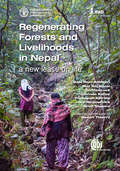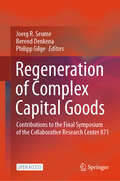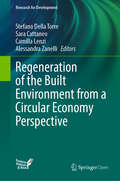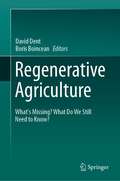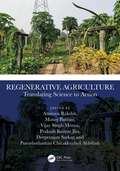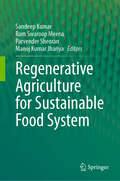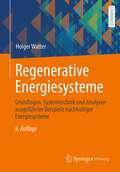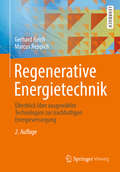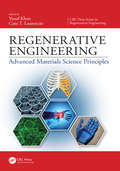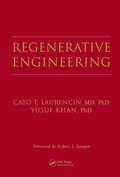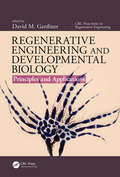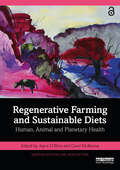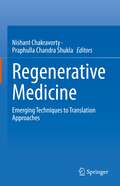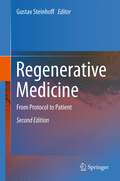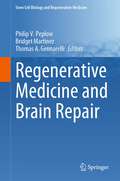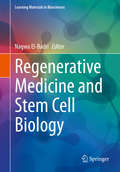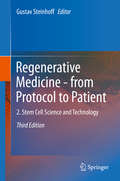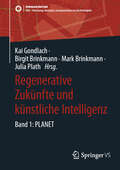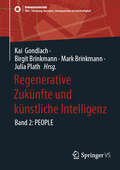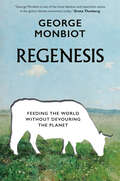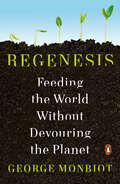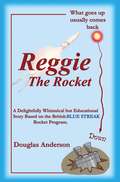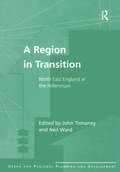- Table View
- List View
Regenerating Forests and Livelihoods in Nepal: A new lease on life
by Bala Ram Adhikari Nav Raj Baral Jim Hancock Govinda Kafley Pashupathi Koirala Jaap Reijmerinck Brett ShapiroRegenerating Forests and Livelihoods in Nepal: A New Lease on Life documents the success story of an innovative rural development programme in the Himalayan foothills, Nepal. The project has made a real difference by transforming increasingly degraded land, where farmers carved out a meagre existence, into a fertile and prosperous zone where they could thrive. Project activities included bringing in effective cultivation techniques to protect the environment and introducing new local crops and goats, as well as promoting entrepreneurial spirit. Every intervention was carefully selected and conducted to mitigate climate change as well as to help farmers become more resilient to its effects. The ingredients of the project's success, from both the technical and human perspectives, are presented in this book, demonstrating people's commitment in a country prone to natural disasters and earthquakes.
Regenerating Forests and Livelihoods in Nepal
by Benoît ThierryRegenerating Forests and Livelihoods in Nepal: A New Lease on Life documents the success story of an innovative rural development programme in the Himalayan foothills, Nepal. The project has made a real difference by transforming increasingly degraded land, where farmers carved out a meagre existence, into a fertile and prosperous zone where they could thrive. Project activities included bringing in effective cultivation techniques to protect the environment and introducing new local crops and goats, as well as promoting entrepreneurial spirit. Every intervention was carefully selected and conducted to mitigate climate change as well as to help farmers become more resilient to its effects. The ingredients of the project's success, from both the technical and human perspectives, are presented in this book, demonstrating people's commitment in a country prone to natural disasters and earthquakes.
Regeneration of Complex Capital Goods: Contributions to the Final Symposium of the Collaborative Research Center 871
by Berend Denkena Joerg R. Seume Philipp GilgeThis open access book compiles the groundbreaking research conducted by the Collaborative Research Center (CRC) 871, centered around the "Regeneration of Complex Capital Goods." This comprehensive work unveils an array of innovative methods developed through CRC 871, designed to revitalize and enhance the functional attributes of these critical assets. From non-destructive characterization of heavily stressed turbine components to the dynamic behavior of regenerated structural elements, each chapter offers a meticulous exploration of diverse facets in the field. The book also addresses the crucial consideration of variability in repair processes and material properties, as well as the comprehensive control of regeneration processes. With insights into simulation-based process design, fast measurement techniques, and resilience-based decision criteria, this volume provides a comprehensive view of the cutting-edge approaches employed. Moreover, readers will find a detailed process chain for condition-based regeneration, offering a practical framework for implementation. Finally, the book sheds light on the importance of targeted public relations in disseminating the invaluable research carried out by Collaborative Research Center 871. This extensive compilation not only showcases the scientific rigor behind maintaining complex capital goods but also demonstrates the collaborative efforts that brought together experts from various fields to push the boundaries of regeneration technology.
Regeneration of the Built Environment from a Circular Economy Perspective (Research for Development)
by Stefano Della Torre Sara Cattaneo Camilla Lenzi Alessandra ZanelliThis open access book explores the strategic importance and advantages of adopting multidisciplinary and multiscalar approaches of inquiry and intervention with respect to the built environment, based on principles of sustainability and circular economy strategies. A series of key challenges are considered in depth from a multidisciplinary perspective, spanning engineering, architecture, and regional and urban economics. These challenges include strategies to relaunch socioeconomic development through regenerative processes, the regeneration of urban spaces from the perspective of resilience, the development and deployment of innovative products and processes in the construction sector in order to comply more fully with the principles of sustainability and circularity, and the development of multiscale approaches to enhance the performance of both the existing building stock and new buildings. The book offers a rich selection of conceptual, empirical, methodological, technical, and case study/project-based research. It will be of value for all who have an interest in regeneration of the built environment from a circular economy perspective.
Regenerative Agriculture: What’s Missing? What Do We Still Need to Know?
by David Dent Boris BoinceanThe food system is our last coal-fired power station, our last diesel engine. This book is a trans-disciplinary approach to what needs to be done to make our food system sustainable and to regenerate soil and water resources, habitat, economy and society. The book brings back classical principles of agronomy and integrates economic, agro-ecological and social perspectives, drawing on a wealth of expertise on the political economy of the food system, Conservation Agriculture, and long-term field experiments. Regenerative agriculture builds on known knowns – like crop rotation, water and nutrient requirements, soil and water conservation, farm-gate prices, international trade and supply chains. It grapples with known unknowns – like weed, pest and disease control without agrochemicals, cover crops for profit as well as protection, mitigating and adapting to the climate crisis, resilience and tipping points in ecosystems, farming systems and societies, and how we can pay for imperative changes. Lastly, it acknowledges unknown unknowns – the things we are oblivious to but which we really must know – like how to liberate the ghettos of the mind inhabited by farmers, agronomists, politicians and societies.
Regenerative Agriculture: Translating Science to Action
by Amitava Rakshit Manoj Parihar Vijay Singh Meena Prakash Kumar Jha Deepranjan Sarkar Purushothaman Chirakkuzhyil AbhilashThis book aims to focus on the current state of knowledge and scientific advances about the complex and intertwined issues of regenerative farming as a transformative solution for offsetting the disastrous climate effects of burning fossil fuels and impairments of natural resource bases. Regenerative agriculture advocates no-till practices, planting cover crops, integrating livestock and crop production, improving animal welfare practices, improving the social and economic well-being of communities, sequestering carbon, improving soil health, and increasing yields and profit with a positive impact on food access or food safety regardless of farm size.This book examines the innovations that will equip agriculture to cope with the competing challenges of addressing food and nutrition security, improving livelihoods, combatting climate change, and sustainably managing natural resources. The scope of this book extends to agricultural scientists, students, consultants, site owners, industrial stakeholders, regulators, and policymakers.
Regenerative Agriculture for Sustainable Food Systems
by Sandeep Kumar Ram Swaroop Meena Parvender Sheoran Manoj Kumar JhariyaThis book aims to present a comprehensive collection of information that combines improved soil and crop productivity, climate-based stress management, enhanced research infrastructure, financial assistance for regenerative technologies, and government subsidies and economic incentives. Considering the importance of soil biodiversity, health, and ecological balance, this book primarily focuses on effective plans and policies for soil management and restoration in agricultural soils. The book covers key areas such as advancing communication strategies to ensure subsidies and incentives for carbon-sequestering farm practices and effectively publicizing the benefits of soil carbon, health, and regenerative practices. It also includes the declaration of rules and regulations to guide policies, programs, and investments in green technologies for soil restoration and ecosystem services, and forming a robust virtual network among farmers, land managers, and their associations to prepare action plans and seek available funding for regenerative farm practices and technologies. Additionally, it promotes research and developmental activities on carbonaceous practices and land-use decisions across various agro-ecological regions and soil types. The central theme emphasizes that maintaining the ecological balance of soil, plants, the environment, and health is crucial for a healthier life and serves as a powerful tool in combating climate change, food and nutritional insecurities, and other environmental concerns. This book is suitable for teachers, researchers, scientists, government planners, policymakers, and students of agricultural sciences. It will also interest national and international climate change scientists, extension workers, and capacity builders.
Regenerative Energiesysteme: Grundlagen, Systemtechnik und Analysen ausgeführter Beispiele nachhaltiger Energiesysteme
by Holger WatterDie erneuerbaren Energien spielen angesichts des fortschreitenden Klimawandels eine größere Rolle denn je. Dieses Lehrbuch stellt die relevanten nachhaltigen Energiesysteme und ihre Funktionsmechanismen dar, geht auf die Einflussparameter ein und erläutert Potentiale durch Überschlagsrechnungen. Die Möglichkeiten für technische Projekte werden vornehmlich für Privatpersonen, aber auch den industriellen Anlagenbau aufgezeigt. Aufgaben und ihre zugehörigen Lösungen unterstützen das Verständnis für die abgebildeten Zusammenhänge. Die 6. Auflage des Buches beinhaltet neben überarbeiteten und neuen Abbildungen einen vollständig neuen Abschnitt zu synthetischen Kraftstoffen. Hier wird neben den zur Verfügung stehenden Prozessen auch auf die Effizienz und physikalischen Grenzen der Verfahren eingegangen.
Regenerative Energietechnik: Überblick Über Ausgewählte Technologien Zur Nachhaltigen Energieversorgung
by Gerhard Reich Marcus ReppichDie Energiewirtschaft wird unter Berücksichtigung der Aspekte Versorgungssicherheit, Wirtschaftlichkeit sowie Klima- und Umweltschutz in den nächsten Jahrzehnten durch umfassende Veränderungen geprägt sein. Dieses Lehrbuch beschreibt Grundlagen ausgewählter Technologien zur Nutzung regenerativer Energiequellen, denen global langfristig das größte Potenzial eingeräumt wird. Den Schwerpunkt bildet die Umwandlung der Solarstrahlung und der Windenergie. Beide Technologien stellen unverzichtbare Bestandteile einer nachhaltigen Energieversorgung dar. Weiterhin werden die Erzeugung, die Speicherung und der Transport von Wasserstoff sowie Bauarten und Anwendungen von Brennstoffzellen erläutert. Beispielaufgaben und Übungen erleichtern und vertiefen das Verständnis.
Regenerative Engineering: Advanced Materials Science Principles (CRC Press Series In Regenerative Engineering)
by Yusuf Khan Cato T. LaurencinThis book focuses on advances made in both materials science and scaffold development techniques, paying close attention to the latest and state-of-the-art research. Chapters delve into a sweeping variety of specific materials categories, from composite materials to bioactive ceramics, exploring how these materials are specifically designed for regenerative engineering applications. Also included are unique chapters on biologically-derived scaffolding, along with 3D printing technology for regenerative engineering. Features: Covers the latest developments in advanced materials for regenerative engineering and medicine. Each chapter is written by world class researchers in various aspects of this medical technology. Provides unique coverage of biologically derived scaffolding. Includes separate chapter on how 3D printing technology is related to regenerative engineering. Includes extensive references at the end of each chapter to enhance further study.
Regenerative Engineering
by Cato T. Laurencin Yusuf KhanDistinct from tissue engineering, which focuses primarily on the repair of tissues, regenerative engineering focuses on the regeneration of tissues: creating living, functional tissue that has the ability to replace organs that are dysfunctional. The challenge of working in an area like regenerative engineering lies, in part, in the breadth of info
Regenerative Engineering and Developmental Biology: Principles and Applications (CRC Press Series In Regenerative Engineering)
by David M. GardinerRegenerative Engineering and Developmental Biology: Principles and Applications examines cutting-edge developments in the field of regenerative engineering. Specific attention is given to activities that embrace the importance of integrating developmental biology and tissue engineering, and how this can move beyond repairing damage to body parts to instead regenerate tissues and organs. The text furthermore focusses on the five legs of the field of regenerative engineering, including: materials, developmental biology, stem cells, physics, and clinical translation. This book was written by leading developmental biologists; each chapter examines the processes that these biologists study and how they can be advanced by using the tools available in tissue engineering/biomaterials. Individual chapters are complete with concluding remarks and thoughts on the future of regenerative engineering. A list of references is also provided to aid the reader with further research. Ultimately, this book achieves two goals. The first encourages the biomedical community to think about how inducing regeneration is an engineering problem. The second goal highlights the discoveries with animal regeneration and how these processes can be engineered to regenerate body parts. Regenerative Engineering and Developmental Biology: Principles and Applications was written with undergraduate and graduate-level biomedical engineering students and biomedical professionals in mind.
Regenerative Farming and Sustainable Diets: Human, Animal and Planetary Health (Earthscan Food and Agriculture)
by Joyce D’Silva Carol McKennaThis book makes the case for an urgent move away from industrial agriculture towards regenerative farming and the promotion of plant-based diets.How we produce, distribute and consume food are critical issues for the health and well-being of humans, animals and the environment. In order to develop a sustainable food system, this book argues for a radical change in farming and food consumption. Containing contributions from world renowned experts, this book promotes regenerative farming as the means to preserve planetary health, establish sustainable, healthy and secure diets and safeguard the welfare of animals. Chapters discuss broad ranging issues from climate change and biodiversity conservation to animal sentience and intensive farming, and the role of financial markets and food businesses. The book concludes with chapters discussing the routes in policy and practice to transforming the food system and achieving real-world change.This book is a must read for students, scholars and policymakers interested in establishing sustainable farming and food systems, for human health, animal welfare and environmental protection.The Open Access version of this book, available at www.taylorfrancis.com, has been made available under a Creative Commons Attribution‑Non Commercial‑No Derivatives (CC‑BY‑NC‑ND) 4.0 license.
Regenerative Medicine: Emerging Techniques to Translation Approaches
by Nishant Chakravorty Praphulla Chandra ShuklaThis book focuses on the recent innovations and therapeutic potentials of regenerative medicine and discusses the applications of stem cells, biomaterials, and tissue engineering in regenerative medicine. The book covers essential aspects of regenerative medicine, including tissue microenvironment, immunological perspectives, stem, and non-stem cell-mediated approaches, imaging techniques, biomarkers, and 3D printing technology. It also reviews the applications of biosensing technologies in regenerative medicine, including biomanufacturing, organ-on-a-chip technologies, and as indicators of therapeutic efficacy. Further, it focuses on the regenerative medicine approaches for diseases of the central nervous system. It also provides the therapeutic potential of regenerative medicine to improve soft tissue and wound healing, cardiovascular, neural, bone, and orofacial regeneration.
Regenerative Medicine
by Gustav SteinhoffRegenerative Medicine is a fastly emerging interdisciplinary field of research and clinical therapies on the repair, replacement or regeneration of cells, tissues or organs in congenital or acquired disease. This new field of research and clinical development focussing on stem cell science and regenerative biology is just starting to be the most fascinating and controversial medical development at the dawn of the 21st century. Viewing the great expectations to restructure and regenerate tissue, organs or organisms the current attempts of scientist and physicians are still in an early phase of development. This new textbook on "Regenerative Medicine - from protocol to patient" is aiming to explain the scientific knowledge and emerging technology as well as the clinical application in different organ systems and diseases. The international leading experts from four continents describe the latest scientific and clinical knowledge of the field of "Regenerative Medicine". The process of translating science of laboratory protocols into therapies is explained in sections on basic science, clinical translation, regulatory, ethical and industrial issues. The textbook is aiming to give the student, the researcher, the health care professional, the physician, and the patient a complete survey on the current scientific basis, therapeutical protocols, clinical translation and practised therapies in Regenerative Medicine.
Regenerative Medicine and Brain Repair (Stem Cell Biology and Regenerative Medicine #75)
by Philip V. Peplow Bridget Martinez Thomas A. GennarelliThis book presents the latest knowledge, trends, and advances in cell transplantation and innovations in developing microspheres, 3D biomaterial constructs to enhance transfer, and cell survival to specific regions of the brain. Neurodegenerative diseases and brain injury are increasing. Medications currently only temporarily reduce some of the symptoms but do not cure or delay progression of the disease. Development of effective treatments dramatically improves the independent living and quality of life of patients. Cell transplantation strategies offer an approach to facilitating brain repair, but efficacy is often limited by low in vivo survival rates of cells that are injected in suspension. Transplanting cells that are attached to or encapsulated within a biomaterial construct has the advantage of maintaining cell-cell and cell-material interactions and improving cell survival in vivo. Biomaterials that have been used in preclinical studies to assist with in vivo cell transfer and survival include heparin-chitosan microspheres, poly(lactic-co-glycolic acid) microspheres, RADA 16 microspheres, poly(desaminotyrosyl tyrosine ethyl ester carbonate) microscale scaffolds, carbon nanotubes, collagen-chitosan scaffolds, poly(L-lactic acid) scaffolds, agarose hydrogels, gelatin methacrylate hydrogels, and agarose micro-columns with an extracellular matrix interior. Incorporating growth factors (e.g., glial-derived neurotrophic factor, neurotrophin 3) into the biomaterial constructs increased cell survival and incorporation into the host tissue. International experts in the fields of both experimental and clinical neurological research contribute chapters to this book and discuss the latest achievements in cell transplantation and matrix-assisted cell transfer/survival technologies for diseases such as Alzheimer’s disease, Parkinson’s disease, and brain injuries such as stroke and traumatic brain injury. It is envisaged that research findings in experimental animal models of Alzheimer’s disease, Parkinson’s disease, traumatic brain injury, and stroke promote clinical trials using biomaterial-assisted transfer of cells.
Regenerative Medicine and Stem Cell Biology: Bench To Bedside (Learning Materials in Biosciences #0)
by Nagwa El-BadriThis textbook covers the basic aspects of stem cell research and applications in regenerative medicine. Each chapter includes a didactic component and a practical section. The book offers readers insights into: How to identify the basic concepts of stem cell biology and the molecular regulation of pluripotency and stem cell development. How to produce induced pluripotent stem cells (iPSCs) and the basics of transfection. The biology of adult stem cells, with particular emphasis on mesenchymal stromal cells and hematopoietic stem cells, and the basic mechanisms that regulate them. How cancer stem cells arise and metastasize, and their properties. How to develop the skills needed to isolate, differentiate and characterize adult stem The clinical significance of stem cell research and the potential problems that need to be overcome. Evaluating the use of stem cells for tissue engineering and therapies (the amniotic membrane) The applications of bio-nanotechnology in stem cell research. How epigenetic mechanisms, including various DNA modifications and histone dynamics, are involved in regulating the potentiality and differentiation of stem cells. The scientific methods, ethical considerations and implications of stem cell research.
Regenerative Medicine - from Protocol to Patient
by Gustav SteinhoffRegenerative medicine is the main field of groundbreaking medical development and therapy using knowledge from developmental and stem cell biology as well as advanced molecular and cellular techniques. This collection of volumes, Regenerative Medicine: From Protocol to Patient, aims to explain the scientific knowledge and emerging technology as well as the clinical application in different organ systems and diseases. International leading experts from all over the world describe the latest scientific and clinical knowledge of the field of regenerative medicine. The process of translating science of laboratory protocols into therapies is explained in sections on regulatory, ethical and industrial issues. The collection is organized into five volumes: (1) Biology of Tissue Regeneration, (2) Stem Cell Science and Technology, (3) Tissue Engineering, Biomaterials and Nanotechnology, (4) Regenerative Therapies I, and (5) Regenerative Therapies II. The textbook gives the student, the researcher, the health care professional, the physician and the patient a complete survey on the current scientific basis, therapeutical protocols, clinical translation and practiced therapies in regenerative medicine. Volume 3: Tissue engineering, Biomaterials and Nanotechnology focuses the development of technologies, which enable an efficient transfer of therapeutic genes and drugs exclusively to target cells and potential bioactive materials for clinical use. Principles of tissue engineering, vector technology, multifunctionalized nanoparticles, biodegradable materials, controlled release, and biointerface technology are described with regard to the development of new clinical cell technology. Imaging and targeting technologies as well as biological aspects of tissue and organ engineering are depicted.
Regenerative Zukünfte und künstliche Intelligenz: Band 1: PLANET (SDG - Forschung, Konzepte, Lösungsansätze zur Nachhaltigkeit)
by Kai Gondlach Birgit Brinkmann Mark Brinkmann Julia PlathDieses Buchprojekt erscheint in drei Teilen mit jeweils einem inhaltlichen Schwerpunkt – PLANET, PEOPLE, PROFIT – und beschäftigt sich übergreifend mit den Nachhaltigkeitszielen der Vereinten Nationen (Sustainable Development Goals, SDGs). Dieser erste Band behandelt die ökologische Dimension der Nachhaltigkeit und umfasst Beiträge, die explizit oder implizit SDGs mit Umweltbezug thematisieren. Die Beiträge und Grußworte international renommierter Expert:innen aus Wissenschaft und Praxis werden durch Begleittexte der Herausgebenden ergänzt. „Wir wissen genug, wir können genug. Wir müssen uns jetzt trauen, den richtigen Weg einzuschlagen“, aus dem Grußwort von Prof. Dr. Johan Rockström, Potsdam-Institut für Klimafolgenforschung.
Regenerative Zukünfte und künstliche Intelligenz: Band 2: PEOPLE (SDG - Forschung, Konzepte, Lösungsansätze zur Nachhaltigkeit)
by Kai Gondlach Birgit Brinkmann Mark Brinkmann Julia PlathDer Band basiert auf den 17 Entwicklungszielen (SDGs) der UNO und entwickelt für die Wirtschaft Zukunftsperspektiven zum Zusammenhang von KI und Nachhaltigkeit.
Regenesis: Feeding the World Without Devouring the Planet
by George Monbiot* GEORGE MONBIOT IS THE WINNER OF THE 2022 ORWELL PRIZE FOR JOURNALISM *What if there were a way to stop climate change and end global hunger at the same time?The way we feed ourselves is destroying the planet, and a collection of crises have brought the global food supply to its breaking point. But it doesn't have to be this way. With technology that already exists, we could sustainably provide everyone on the planet with a healthy diet. By cultivating hydrogen-eating bacteria, deep-rooted plants, and much richer communities of insects--coupled with existing technology to reduce our dependence on meat--we can dramatically reduce our carbon footprint, solve world hunger, and halt the sixth extinction at the same time.George Monbiot is an internationally renowned climate activist, widely known for bringing bold, creative thinking to the climate and ecological crises facing our planet. Now, he turns his attention to the global food system to offer a reimagining of the way we feed ourselves on a scale to fit the urgency of the problems we face.
Regenesis: Feeding the World Without Devouring the Planet
by George Monbiot&“This remarkable book, staring curiously down at the soil beneath our feet, points us convincingly in one of the directions we must travel. I learned something on every page.&” —Bill McKibbenFor the first time since the Neolithic, we have the opportunity to transform not only our food system but our entire relationship to the living world. Farming is the world's greatest cause of environmental destruction – and the one we are least prepared to talk about. We criticise urban sprawl, but farming sprawls across thirty times as much land. We have ploughed, fenced and grazed great tracts of the planet, felling forests, killing wildlife, and poisoning rivers and oceans to feed ourselves. Yet millions still go hungry. Now the food system itself is beginning to falter. But, as George Monbiot shows us in this brilliant, bracingly original new book, we can resolve the biggest of our dilemmas and feed the world without devouring the planet. Regenesis is a breathtaking vision of a new future for food and for humanity. Drawing on astonishing advances in soil ecology, Monbiot reveals how our changing understanding of the world beneath our feet could allow us to grow more food with less farming. He meets the people who are unlocking these methods, from the fruit and vegetable grower revolutionising our understanding of fertility; through breeders of perennial grains, liberating the land from ploughs and poisons; to the scientists pioneering new ways to grow protein and fat. Together, they show how the tiniest life forms could help us make peace with the planet, restore its living systems, and replace the age of extinction with an age of regenesis.
Reggie The Rocket: What Goes Up Usually Comes Back Down
by Douglas AndersonThe story of Reggie The Rocket closely tracks the history of the 1960s British Blue Streak rocket program. The author Douglas Anderson worked on the assembly and testing of the Rolls-Royce RZ2 engines powering the Blue Streak and was present in Woomera, Australia, for the launch of F3. Based on that experience, Douglas has assigned a personality to the rockets and has thus woven a whimsical element into an otherwise historical account of the Blue Streak Program. Reggie The Rocket is F3, the third in line to be launched, and Douglas was there to cheer him on. It is a sad reality that most heavy-lift booster rockets have been launched only to return to earth as scrap metal or to have disappeared into the ocean depths. Only now, fifty years after Blue Streak, are serious attempts being made to return booster rockets safely back to the launch pad under their own power so they can be reused. The days of 'throw away' rockets must surely come to an end if humans are to continue with orbital flights and deep space exploration.
A Region in Transition: North East England at the Millennium (Urban and Regional Planning and Development Series)
by John Tomaney Neil WardThe UK has now joined a Europe-wide trend towards more devolved forms of government (e.g. Scotland, Wales and Northern Ireland Assemblies). In the context of this general trend towards regionalizm as a focus for public policy and as a source of cultural and political identity, an interdisciplinary team from Newcastle University combine to analyze how this affects the North East of England. There has been comparatively little published on the contemporary development of English Regions and the North East is a particularly important case study, as throughout the 1990s it has experienced a range of social, economic and political changes. This book will contribute to key contemporary policy debates, which will affect all of the English regions and should be read by all social scientists interested in European regional development.
Regional Advantage
by Annalee SaxenianLike the Greeks who sailed with Jason in search of the Golden Fleece, the new Argonauts--foreign-born, technically skilled entrepreneurs who travel back and forth between Silicon Valley and their home countries--seek their fortune in distant lands by launching companies far from established centers of skill and technology. Their story illuminates profound transformations in the global economy. Economic geographer AnnaLee Saxenian has followed this transformation, exploring one of its great paradoxes: how the "brain drain" has become "brain circulation," a powerful economic force for development of formerly peripheral regions. The new Argonauts--armed with Silicon Valley experience and relationships and the ability to operate in two countries simultaneously--quickly identify market opportunities, locate foreign partners, and manage cross-border business operations. The New Argonauts extends Saxenian's pioneering research into the dynamics of competition in Silicon Valley. The book brings a fresh perspective to the way that technology entrepreneurs build regional advantage in order to compete in global markets. Scholars, policymakers, and business leaders will benefit from Saxenian's firsthand research into the investors and entrepreneurs who return home to start new companies while remaining tied to powerful economic and professional communities in the United States. For Americans accustomed to unchallenged economic domination, the fast-growing capabilities of China and India may seem threatening. But as Saxenian convincingly displays in this pathbreaking book, the Argonauts have made America richer, not poorer.
